Rescuers were still pulling survivors from the rubble when one of several aftershocks struck on Sunday, sending people in Mandalay — Myanmar’s second-largest city, and the epicenter of Friday’s 7.7 magnitude earthquake — screaming into the streets.
Already suffering the brutal toll of four years of civil war, one of the world’s poorest countries was now facing the humanitarian crisis and crushing toll of a powerful earthquake that has killed at least 1,600 people and counting, as aid struggled to reach those in need over buckled roads and crumbled infrastructure.
Adding to the injury, Myanmar’s ruling military junta continued to drop bombs, as the civil war intersected with the natural disaster, deepening the crisis.
Friday’s earthquake has crippled the nation’s essential services and made critical stretches of its roads impassable. Hospitals are overwhelmed and running short on medical equipment and blood.
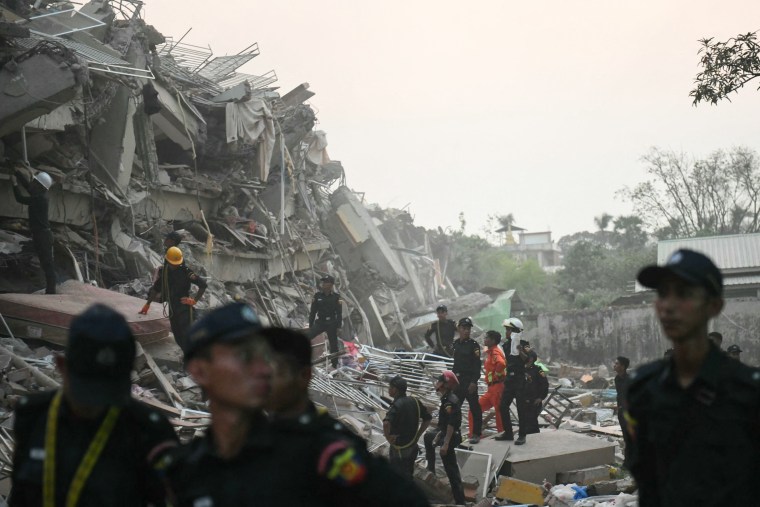
Severely damaged roads and piles of debris, including the one that runs north to Mandalay from Naypyidaw, the capital, and Yangon, Myanmar’s largest city, are slowing the entry of aid into the most affected areas, according to the United Nations humanitarian aid office, further challenged by “telecommunications and internet disruptions.”
Immediate needs include food, clothing, blankets, kitchen sets, emergency shelters, water, sanitation and hygiene supplies, the U.N. said. “Hospital and health facilities have sustained extensive damage or destruction.”
As aid trickles in, residents and rescuers are digging through the debris in search of survivors.
Video verified by Reuters showed Chinese rescuers working through the night in Naypyidaw, Using their hands and shovels, they dig through the wreckage of a collapsed building before pulling an elderly person, barely conscious, from the rubble.
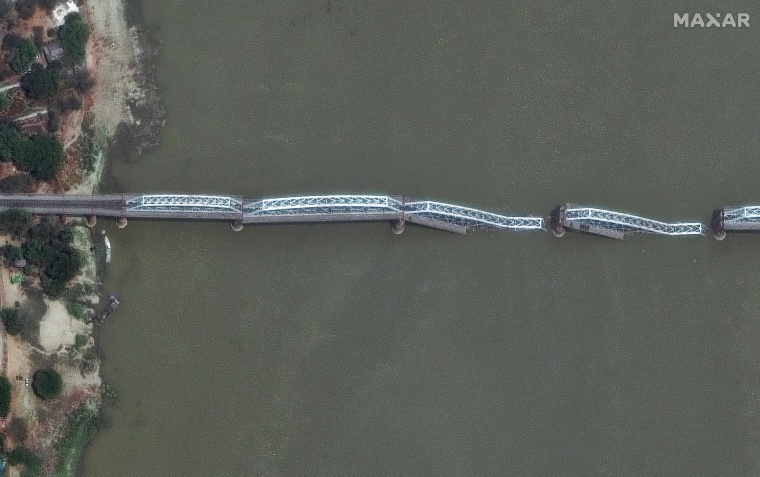
At the Sky Villa Condominium, which collapsed in Mandalay, trapping dozens of people, rescuers pulled a woman, weeping, from the debris. According to the BBC’s Burmese service, 29 people have been rescued from the complex, and nine bodies recovered.
“Thousands of people are spending the nights on the streets or open spaces due to the damage and destruction to home or fearing further quakes,” the U.N. said in a statement Saturday.
Some countries have pitched in to help Myanmar respond to the emergency.
Russia sent two planes with 120 rescuers and supplies, according to state news agency TASS, while the Chinese embassy said on Facebook it had dispatched a 37-person team to Yangon with medicine and equipment to detect survivors.
Teams from India, Singapore and Thailand are also working on the ground, according to Reuters.
In neighboring Thailand, where several people have died and dozens remain missing, drones buzz over the mountain of dust and twisted rebar that was once a 30-storey building, searching for signs of life.
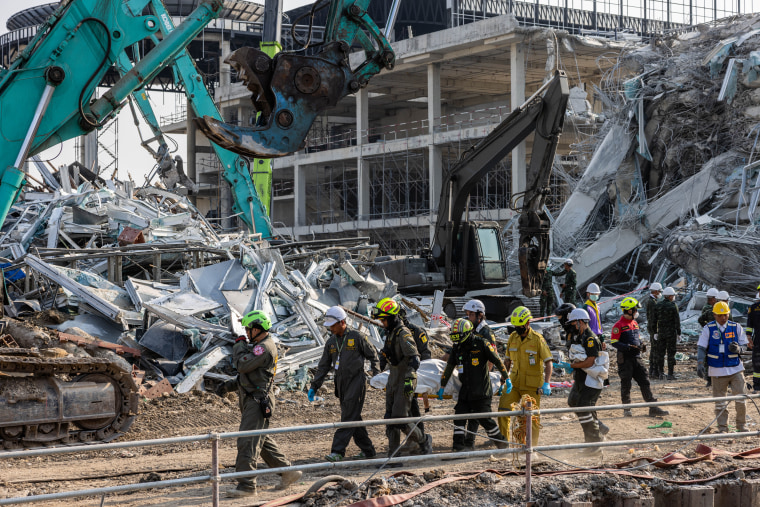
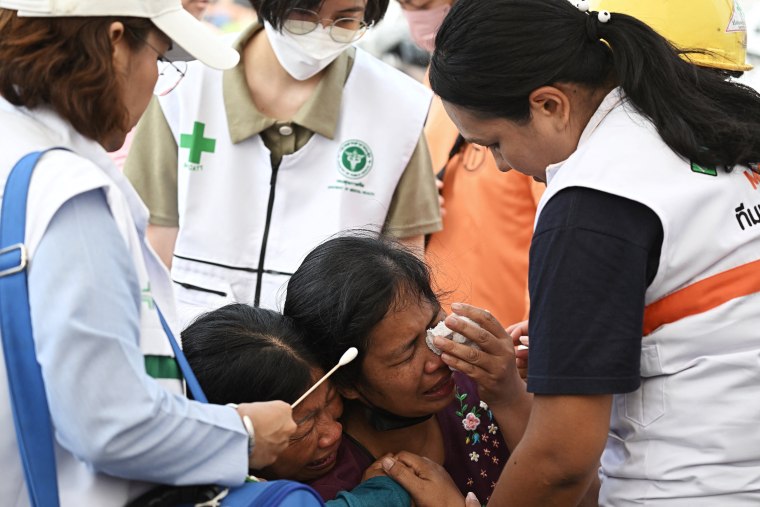
Rescue teams working on the ground said that seven people were rescued alive within 24 hours of the earthquake, and that so far nobody had been rescued on Sunday. For now, the Governor of Bangkok, Chadchart Sittipunt, said signs of life could still be detected in the wreckage.
However, rain is threatening to slow down the rescue efforts. More than 48 hours since the building collapsed, relatives of the trapped inside are still at the site — watching and hoping that more of the missing will be found soon.
On Sunday team of U.S. Air Force personnel arrived in Bangkok from Japan, with four men dressed partly in camouflage carrying bags of gear and a suitcase into the search zone.
“We’re here to help with the rescue effort,” one of them told NBC’s crew on the ground.
But Myanmar has borne the heaviest toll of the disaster, piled onto the crises that preceded it long before the quake struck.
According to the International Rescue Committee, more than 19 million people are in urgent need of humanitarian aid.
The World Food Programme says food insecurity in Myanmar affects 15.2 million people. Last year, the U.N. Security Council expressed concern for the “the denial of access to medicine and medical care” following attacks on health-care facilities and blockades on medicines.
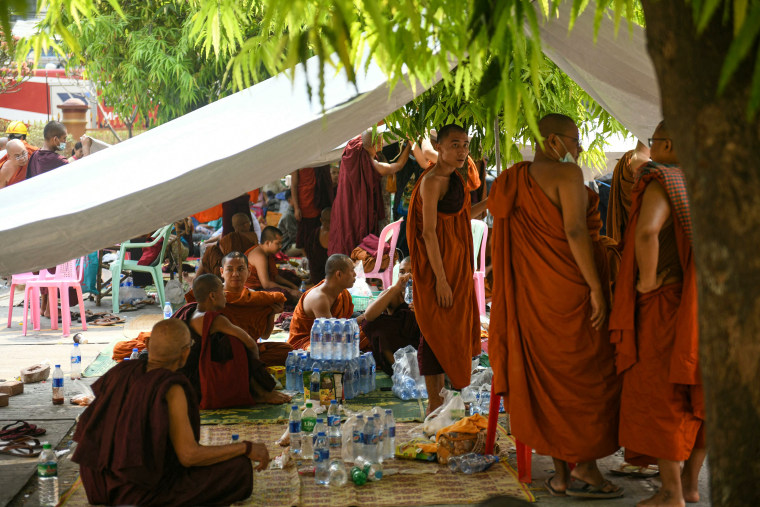
The military regime seized power in a coup four years ago, ousting the government of the democratically-elected Nobel Prize laureate, Aung San Suu Kyi. Since then, the country has been gripped by civil war, as the junta fights to crush armed rebel groups in the country, including the National Unity Government (NUG), Myanmar’s government in exile.
On Saturday, the NUG announced a two-week pause of “offensive military operations, except for defensive actions” in earthquake affected areas. But the junta has not followed suit.
BBC Burmese reported that seven people were killed in an air strike in Naungcho in northern Shan state less than three hours after the first quake struck.
Pro-democracy rebel groups fighting to remove the military from power also reported aerial bombings in Chang-U township in northwest Sagaing near the epicenter of the quake, according to the BBC.
Tom Andrews, the U.N. Special Rapporteur for Myanmar, called for an “immediate ceasefire” and a suspension of military conscription.
“Aid workers should not have to fear arrest and there should be no obstructions to aid getting to where it is most needed,” he said Sunday on X. “Every second counts.”
For now, bombs continue to fall on a country that is still counting its dead.
Freddie Clayton reported from London, and Janis Mackey Frayer and Nat Sumon from Bangkok.


